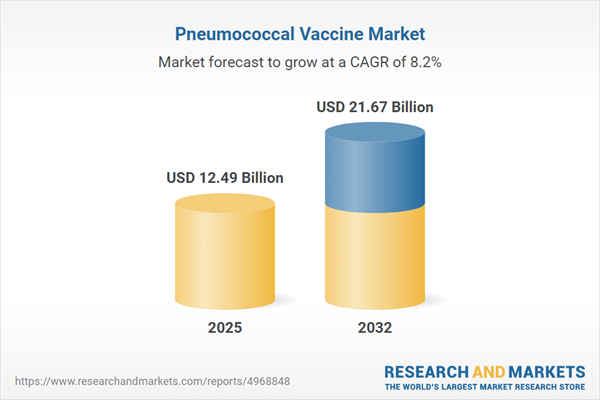Speak directly to the analyst to clarify any post sales queries you may have.
Senior decision-makers in the pneumococcal vaccine market face a fast-evolving environment characterized by regulatory complexity, rising technological expectations, and the imperative for digitally empowered operations. Strategic adaptation and steady innovation now define competitive leadership across this global sector.
Market Snapshot: Pneumococcal Vaccine Market Growth
In 2024, the global pneumococcal vaccine market was valued at USD 11.56 billion. Industry forecasts anticipate growth to USD 12.49 billion in 2025, led by a compound annual growth rate (CAGR) of 8.16%. By 2032, projections show the market could reach USD 21.67 billion. This growth reflects technological advances in vaccine platforms, expanded immunization campaigns covering broader demographic segments, and greater distribution channel digitization. Leadership teams are responding by enhancing procurement frameworks, increasing regulatory synchronization, and cultivating strategic partnerships to reinforce market resilience.
Pneumococcal Vaccine Market: Scope & Segmentation
Comprehensive segmentation strategies enable effective responses to continuing shifts in global healthcare needs and sector challenges. Executives use nuanced analysis of market segments to focus planning and resource deployment.
- Vaccine Types: Next-generation conjugate vaccines like PCV13, PCV15, and PCV20, along with established polysaccharide-based formulations, foster agile immunization strategies for various populations.
- Age Groups: Distinct vaccination approaches for pediatrics, adults, and older populations allow for targeted health interventions that align with evolving epidemiological data.
- Distribution Channels: Digital tools integrated across supply pathways improve inventory oversight and response speed, reducing risks tied to supply volatility and distribution challenges.
- End Users: Hospitals, ambulatory centers, and specialty clinics benefit from scalable inventory management systems and advanced storage protocols to maintain reliable patient access and operational integrity.
- Regions: Tailored strategic plans across the Americas, Europe, Asia-Pacific, the Middle East, and Africa account for varied regulatory landscapes, infrastructure capacities, and policy environments.
- Key Companies: Market leadership includes AstraZeneca PLC, Biovac, F. Hoffmann-La Roche AG, GlaxoSmithKline plc, Incepta Pharmaceuticals Ltd., Lonza AG, Merck & Co., Inc., Panacea Biotec Limited, Pfizer Inc., Sanofi SA, Serum Institute of India Pvt. Ltd., Vaxcyte Inc., and Walvax Biotechnology Co., Ltd., all continually investing in R&D, digital modernization, and cross-sector collaboration.
Pneumococcal Vaccine Market: Key Takeaways for Decision Makers
- Adoption of innovative vaccine platforms broadens immunization coverage and enhances supply chain agility through advanced digital capabilities.
- Adaptive operational models support compliant navigation of shifting immunization standards and help mitigate regulatory risk exposures.
- Digitally enhanced procurement and logistics systems allow for real-time operational insights, supporting fast adaptation in unpredictable healthcare markets.
- Customized vaccine initiatives designed for specific age cohorts and clinical needs optimize health impact and advance resource deployment efficiency.
- Regional strategies reflecting differing health systems and regulations are essential to maintaining uninterrupted market access.
- Analytical integration in planning aligns demand, procurement, and market responsiveness, improving both payer and patient outcome alignment.
Tariff Impact: Strategic Considerations from Recent U.S. Measures
New tariff policies in the United States have driven up material and input costs for pneumococcal vaccine production. Executives are reducing these pressures by shifting certain manufacturing activities to domestic sites, renegotiating supply contracts, and collaborating with regulators to sustain production and distribution continuity even as external requirements shift.
Competitive Dynamics & Innovation
Increased competition is accelerating improvements in vaccine serotype diversity and immunogenicity. Leading companies are expanding biotechnology collaborations, deploying digital solutions for inventory transparency, and leveraging analytics to unlock new growth prospects. These adaptive innovation strategies help organizations respond effectively to changing disease patterns and sector demands, maintaining operational flexibility and competitiveness globally.
Regional Variances and Emerging Priorities
Regional operational models adapt to local infrastructure and health system capabilities. In the Americas, advanced cold chain systems support reliable vaccine delivery. Asia-Pacific’s early adoption of digital supply networks enables swift local market response, while the Middle East and Africa prioritize international partnerships to improve vaccination reach and public health outcomes. These region-specific approaches help drive greater immunization coverage and promote equitable health system strengthening.
Methodology & Data Sources
This market analysis integrates evidence from peer-reviewed publications, regulatory submissions, industry expert interviews, and current clinical trial data. Manufacturer feedback and multiple cross-verification steps ensure actionable and reliable insights for senior decision-makers.
Why This Report Matters
- Provides leaders with robust intelligence for procurement optimization and risk control using multi-source, validated data.
- Enables informed strategic planning through practical segmentation insights tailored to prevailing technologies, regulations, and shifting market dynamics.
- Supports corporate focus on combining innovation and compliance needed for secure and sustainable growth in globally competitive settings.
Conclusion
Holistic segmentation, anticipatory planning, and purposeful partnerships empower senior executives to address emerging risks and capitalize on new opportunities in the pneumococcal vaccine market with agility and confidence.
Additional Product Information:
- Purchase of this report includes 1 year online access with quarterly updates.
- This report can be updated on request. Please contact our Customer Experience team using the Ask a Question widget on our website.
Table of Contents
3. Executive Summary
4. Market Overview
7. Cumulative Impact of Artificial Intelligence 2025
Companies Mentioned
The companies profiled in this Pneumococcal Vaccine market report include:- AstraZeneca PLC
- Biological E. Limited
- Biovac
- F. Hoffmann-La Roche AG
- GlaxoSmithKline PLC
- Incepta Pharmaceuticals Ltd.
- Lonza AG
- Merck & Co., Inc.
- Panacea Biotec Limited
- Pfizer, Inc.
- Sanofi SA
- Serum Institute of India Pvt. Ltd.
- Vaxcyte Inc.
- Walvax Biotechnology Co., Ltd.
Table Information
| Report Attribute | Details |
|---|---|
| No. of Pages | 189 |
| Published | November 2025 |
| Forecast Period | 2025 - 2032 |
| Estimated Market Value ( USD | $ 12.49 Billion |
| Forecasted Market Value ( USD | $ 21.67 Billion |
| Compound Annual Growth Rate | 8.1% |
| Regions Covered | Global |
| No. of Companies Mentioned | 15 |









